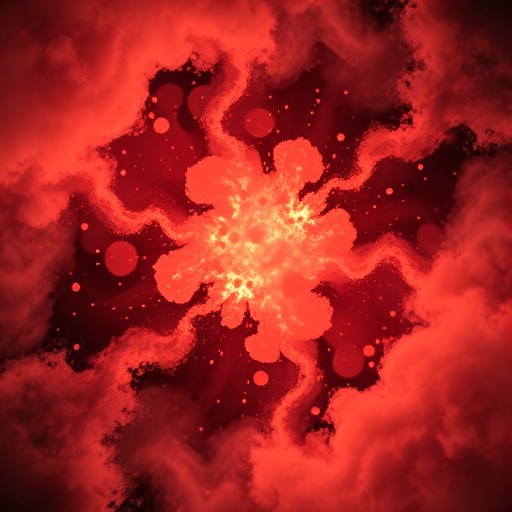In a groundbreaking study published in Proceedings of the National Academy of Sciences, researchers at Emory University have harnessed the power of machine learning to uncover novel insights into dusty plasma, a complex state of matter. This research, led by experimental physicist Justin Burton and theoretical physicist Ilya Nemenman, signifies a transformative step in the interplay between artificial intelligence and foundational physics, illustrating a new way to explore the laws that govern many-body systems.
Dusty plasma, a mixture of ionized gas and charged dust particles, can be found in diverse settings, from space environments to terrestrial occurrences like wildfire smoke. With plasmas considered the fourth state of matter, they constitute roughly 99.9% of the visible universe, manifesting remarkable properties such as electrical conductivity. The inclusion of dust particles into the plasma framework adds layers of complexity, warranting a deeper understanding of non-reciprocal forces—where interactions depend on the direction of the forces exerted.
This study is particularly noteworthy, not just for its application of AI as a tool for data assessment or predictive modeling, but as a method to discover new physics. According to Burton, the neural network employed in this research was deliberately designed to allow for a clear understanding of the underlying physical principles it identifies. This contrasts with typical AI applications, which often operate as “black boxes,” rendering their inner workings opaque to researchers.
.adsslot_10coS4MvNp{ width:728px !important; height:90px !important; }
@media (max-width:1199px) { .adsslot_10coS4MvNp{ width:468px !important; height:60px !important; } }
@media (max-width:767px) { .adsslot_10coS4MvNp{ width:320px !important; height:50px !important; } }
ADVERTISEMENT
Utilizing the data generated from their experiments, the researchers trained their neural network to account for various contributions to particle motion—these included the effects of velocity or drag force, and the forces exerted by the surrounding environment and inter-particle interactions. This meticulous design facilitated an unprecedented accuracy in predicting non-reciprocal interactions among the particles.
One of the most compelling findings from this research is the re-evaluation of long-held assumptions regarding the interactions between particles in dusty plasma. Past theories claimed that larger dust particles would proportionately possess more charge. The Emory researchers discovered that while size indeed affects charge, the relationship is not strictly linear but depends on factors such as the plasma’s density and temperature. Such insights challenge conventional wisdom and hold significant implications for the field of plasma physics.
Furthermore, the researchers illuminated misconceptions regarding how forces between particles dissipate with distance. The previous consensus suggested an exponential decline in force, independent of particle size; however, their findings indicate that the rate at which forces drop off is, in fact, influenced by the size of the particles involved. By correcting these inaccuracies, the team not only enhances the foundational knowledge within plasma physics but also lays the groundwork for further scientific inquiries.
The interdisciplinary nature of this research highlights the potential for AI to bridge the gap between disparate fields—plasma physics and biophysics in this case. Nemenman’s interest in collective motion, particularly in biological contexts such as cancer metastasis, suggests that the approaches and tools developed in this dusty plasma study could extend to living systems. Understanding how collective behavior emerges from individual interactions could unravel critical pathways in health and disease.
As the study opens new avenues for research, the implications extend to various applications, from industrial materials like paints and inks to studies of cellular dynamics within organisms. By deciphering the principles underlying many-body systems, the researchers aim to provide a framework that can be applied across scientific disciplines, potentially accelerating the pace of discovery in complex systems.
Ultimately, the work conducted at Emory showcases not only the versatility of machine learning in physics but also the importance of human expertise in guiding AI applications. While the framework can infer new physics, it necessitates careful human oversight to ensure that insights drawn from AI are effectively interpreted and validated within established scientific paradigms.
The researchers anticipate that their discoveries from dusty plasma could catalyze further exploration into other complex systems, offering a universal model for understanding collective behavior. As highlighted by Burton, this work aligns with the optimistic notion of using AI to probe realms previously unexplored, reminiscent of the aspirational sentiment found in science fiction, where technology expands the horizons of knowledge.
In conclusion, the melding of machine learning with physics represents a paradigm shift in how scientific research can be conducted. The significant advancements made by the Emory University team are likely to inspire further interdisciplinary collaborations, pushing the boundaries of both artificial intelligence and fundamental science, guiding researchers towards uncovering the mysteries of our universe with an unprecedented lens of understanding.
Subject of Research: Non-reciprocal forces in dusty plasma
Article Title: Physics-tailored machine learning reveals unexpected physics in dusty plasma
News Publication Date: 31-Jul-2025
Web References: Proceedings of the National Academy of Sciences
References: Not applicable
Image Credits: Not applicable
Keywords
Artificial Intelligence, Neural Network Processing, Machine Learning, Particle Physics, Plasma Physics, Theoretical Physics
Tags: AI in physics researchcomplex states of matterdusty plasma propertieselectrical conductivity in dusty plasmaemerging technologies in physicsimplications of AI on foundational physicsinterdisciplinary research in physicsmachine learning in plasma studiesnon-reciprocal forces in plasmasnovel insights in many-body systemstransformative AI applications in scienceunderstanding plasma dynamics.





